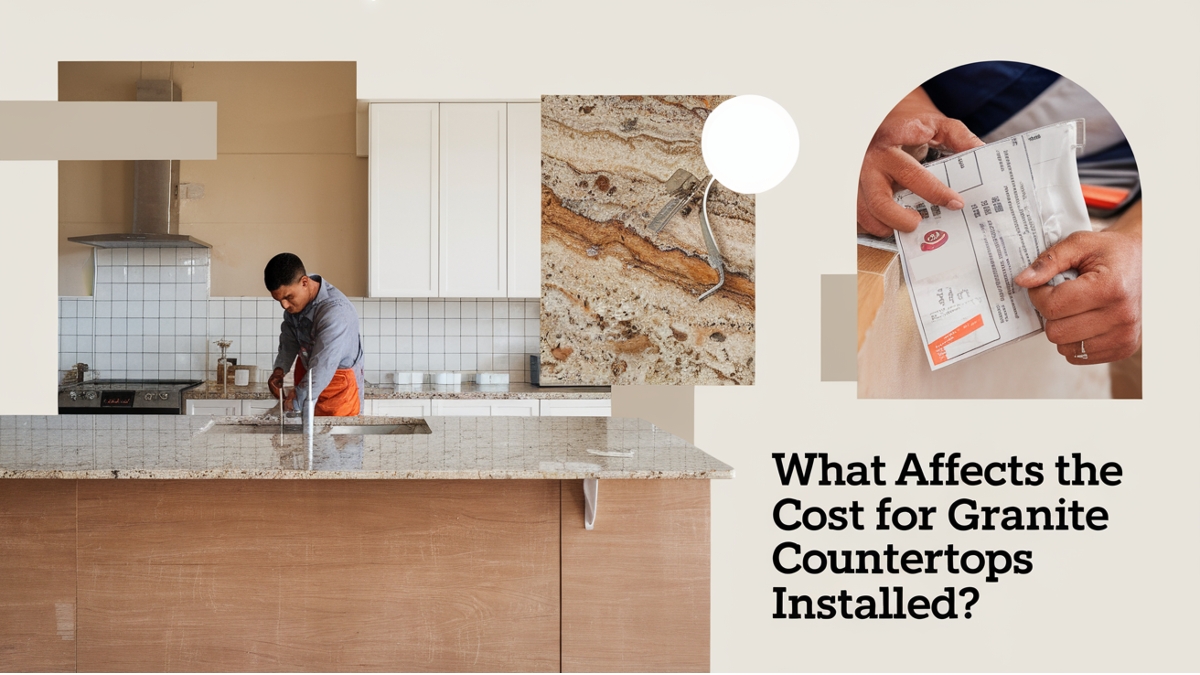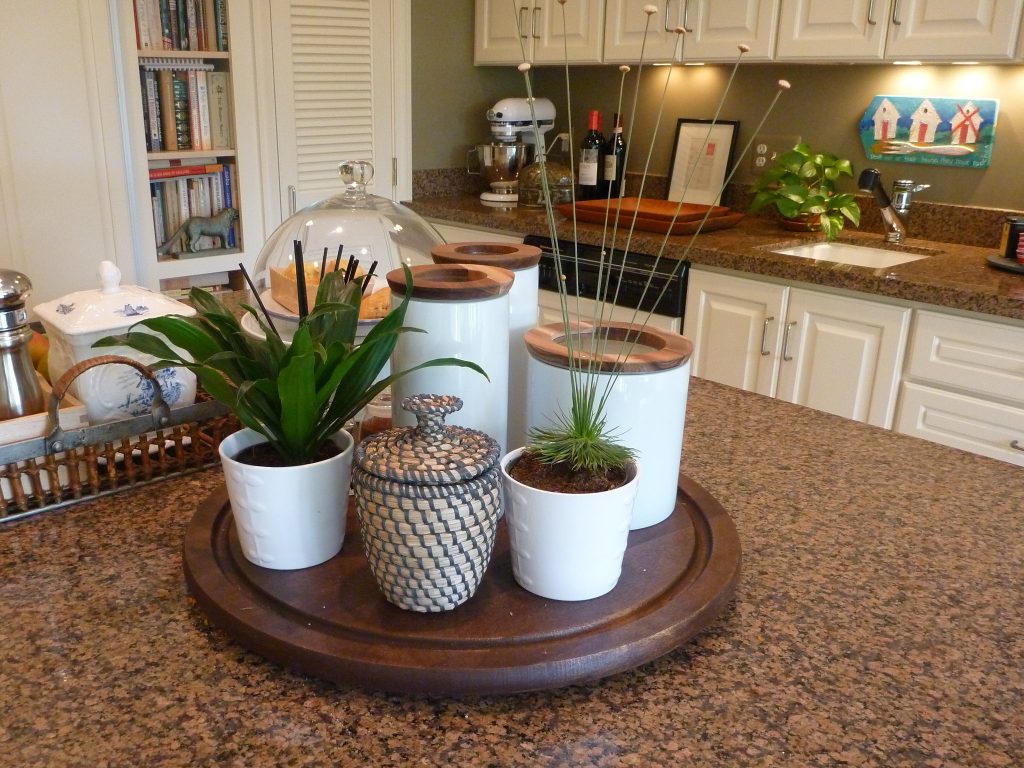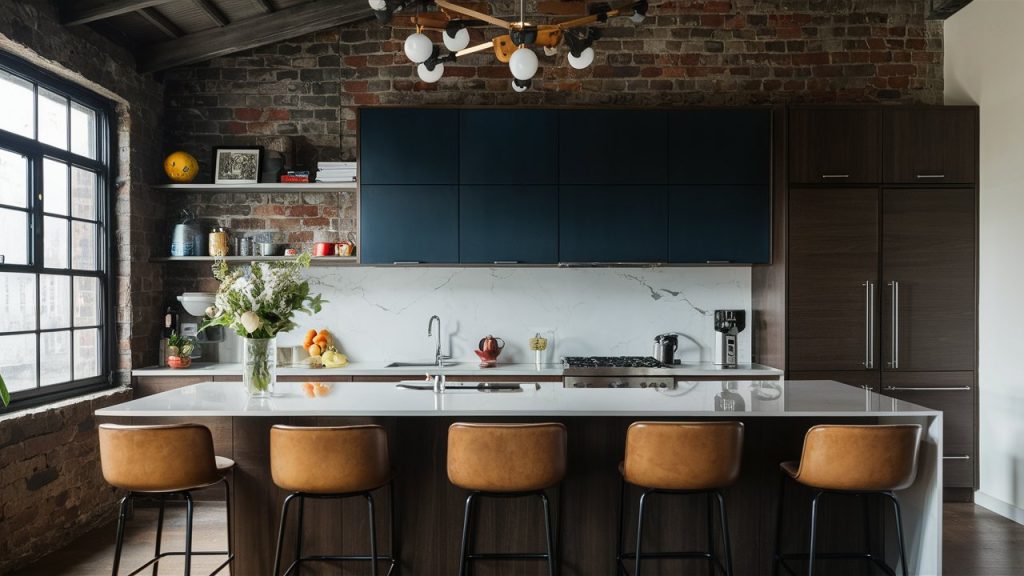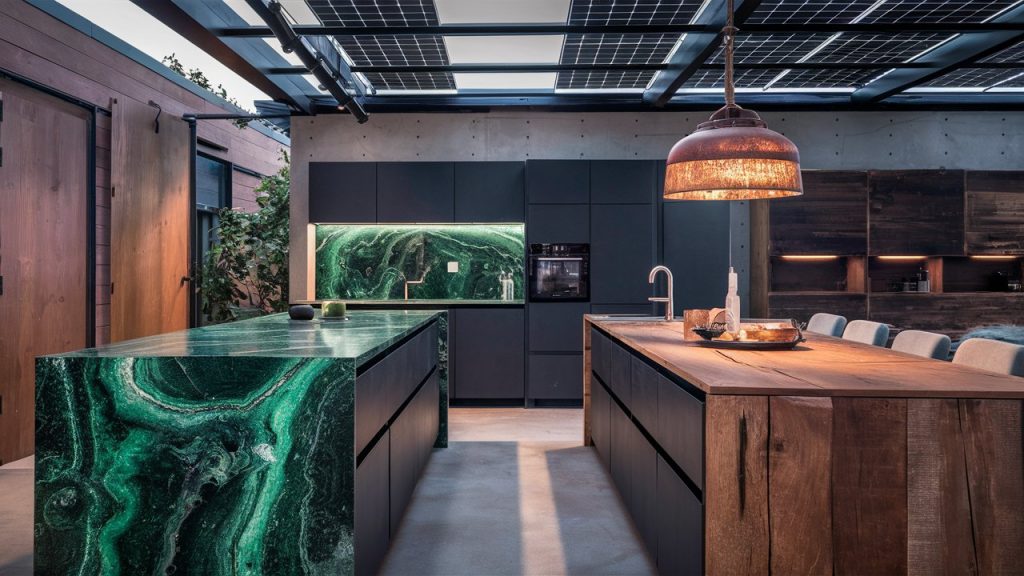Granite countertops are a staple in modern kitchens and bathrooms, known for their durability, elegance, and ability to increase home value. However, the cost for granite countertops installed can vary dramatically based on several key factors. From the type of granite you select to the complexity of the installation process, understanding these elements will help you budget effectively and avoid common pitfalls. Whether you’re a homeowner planning a renovation, a contractor giving a quote, or a designer working with a client, this comprehensive guide will provide you with all the information you need.
In this article, we will break down the different aspects that influence granite countertop costs, including the quality of the granite, installation requirements, and added features such as edge profiles and finishes. We’ll also cover ways to save on your project while ensuring the final result is a high-quality addition to your home.
Key Takeaways
Table of Contents
Granite Type and Quality
When it comes to granite countertops, quality and type are two of the most important factors that affect the cost for granite countertops installed. Granite comes in a wide range of colors, patterns, and qualities, and its price will depend largely on where it’s sourced and the level of rarity in the material.
Standard vs. Premium Granite
Standard granite options, such as shades of beige, gray, and white, tend to be more affordable. These stones are widely available and are typically sourced from quarries in countries with abundant granite deposits, like Brazil, India, and the United States. On the other hand, premium granite varieties feature more complex veining or more vibrant colors. These often come from specific locations and may involve more labor-intensive quarrying processes, leading to higher costs.
Exotic Granite
Some of the most expensive granite varieties are considered exotic, often prized for their unique patterns or rare color combinations. Stones like Blue Pearl from Norway, and the stunning Verde Alpi from Italy, fall into this category. Due to their limited availability and the cost of international transportation, exotic granite is typically priced much higher than standard options.
Real-world example: A client in California looking to install a luxury kitchen remodel might opt for a rare Blue Bahia granite, which can cost over $100 per square foot, compared to more standard granite options, which might cost only $40 to $60 per square foot.
This price fluctuation is a critical element for contractors and designers to understand when creating accurate project estimates for clients. Sourcing decisions also play a role. Local suppliers typically offer lower shipping fees, but international imports come with additional transportation costs that should be factored into the overall price.
Granite Thickness and Size
The thickness and size of granite countertops are another crucial determinant of the cost for granite countertops installed. These factors can significantly impact the overall material and installation costs.
Standard vs. Thicker Granite
Most granite countertops come in 1.25-inch thickness, which is considered standard. However, thicker granite, such as 2-inch slabs, tends to be more expensive due to the increased material volume and the labor required to handle and install them. Thicker slabs also provide a more substantial, luxurious feel but are heavier and require additional support structures.
For larger kitchens or unique countertop layouts, the size of the granite slab can also influence the cost. If your kitchen requires a custom cut, particularly with intricate curves or larger islands, expect to pay a premium for the additional labor involved in cutting the stone precisely.
Real-world example: For a spacious kitchen with a large island, one might need a slab of granite measuring 10 feet by 4 feet. This will cost more compared to a standard-sized countertop of similar square footage due to the custom dimensions and additional fabrication required.
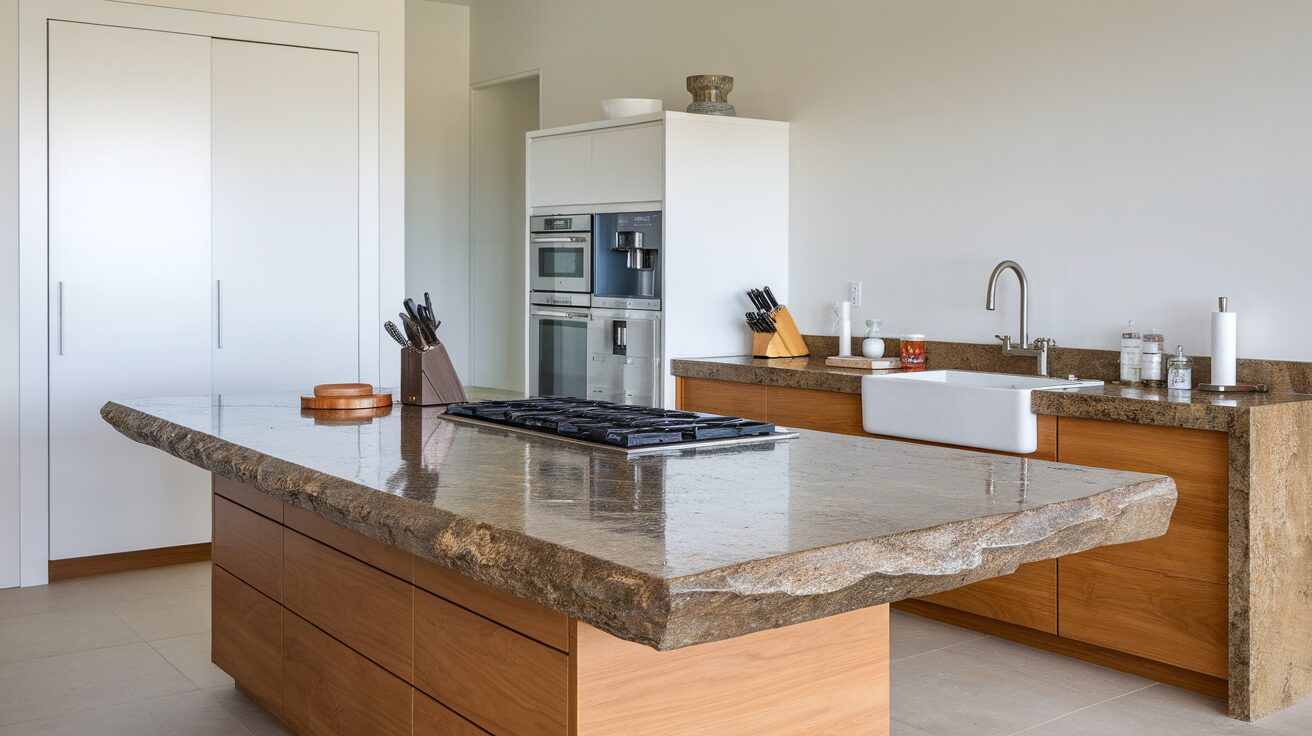
Large kitchen island with thick granite countertop
Granite Finish and Edge Profiles
Granite countertops come in a variety of finishes and edge profiles, both of which can significantly affect the cost for granite countertops installed. Each finish requires specific techniques and can alter the final price based on complexity.
Granite Finishes
Edge Profiles
Granite countertops can have simple edge profiles, like straight, eased, or bullnose, or more intricate profiles, such as ogee or beveled edges. Custom edge profiles often require more labor to create and can raise the price of both the material and installation.
For instance, a simple straight edge may cost an additional $2-$5 per linear foot, while a custom ogee edge can add $10-$20 per linear foot to the cost.
Labor Costs for Installation
Labor costs are another significant factor that affects the cost for granite countertops installed. Professional installers are required to ensure the granite is accurately measured, cut, and fitted. Installation labor rates depend on several factors, including the complexity of the project, location, and the skill level of the installers.
Standard vs. Complex Installations
For a standard installation of granite countertops, which involves relatively simple cuts and fitting, labor may cost around $40 to $70 per hour. However, for more complex installations, such as those involving large islands, intricate seams, or custom edge profiles, labor costs can rise to $100 per hour or more.
Real-world example: In high-cost areas like New York City or San Francisco, labor rates for granite installation can range from $75 to $120 per hour due to the higher cost of living and demand for skilled labor.
Table: Breakdown of labor costs by region and complexity
Region | Labor Cost per Hour | Standard Installation | Complex Installation |
|---|---|---|---|
Small Town | $35 – $55 | $1,200 – $2,000 | $2,000 – $3,500 |
Urban Areas | $55 – $85 | $1,500 – $2,500 | $3,500 – $5,000 |
High-Cost Cities | $85 – $120 | $2,000 – $3,500 | $5,000+ |
Granite Supplier and Sourcing
Where you source your granite plays a major role in the cost for granite countertops installed. Granite can either be sourced locally or imported from international quarries. Local suppliers often offer better prices due to lower shipping fees, but international sourcing may offer a broader variety and higher-quality materials.
Local vs. International Suppliers
Local suppliers tend to offer granite that’s readily available and less expensive to transport. However, if you’re looking for a more unique selection of stones, you may need to go through an international supplier, which could increase your overall costs. This is especially true if you are purchasing high-end or rare stones, which come with a shipping premium.
Real-world example: A homeowner in a metropolitan area might opt for a locally sourced granite slab that costs $50 per square foot. However, if they choose to source a rare stone from overseas, such as the sought-after Super White Granite from Brazil, their total cost could rise by 20-30% due to international shipping fees.

Display of granite slabs at a supplier’s showroom
Additional Costs: Sealant, Maintenance, and Extras
Once your granite countertops are installed, there are several additional costs that you should anticipate. These might include sealing, regular maintenance, and any custom additions like backsplashes, cutouts, or inlays.
Granite countertops typically need to be sealed to prevent staining, and this process should be repeated every 1-3 years, depending on the usage. Sealing can cost anywhere from $0.50 to $2.00 per square foot, depending on the type of sealer used and the granite’s porosity.
In addition, optional custom additions like backsplashes or sink cutouts may increase the price. For example, a sink cutout can cost anywhere from $150 to $300 per cut, depending on the complexity and location of the cutout.
Conclusion
The cost for granite countertops installed is not a one-size-fits-all figure—it varies depending on multiple factors, from the granite type and thickness to the complexity of installation and labor costs. By understanding these elements and doing your research, you can make informed decisions about your granite countertop project and avoid unexpected costs.
Frequently Asked Questions
How much is 30 square feet of granite countertops?
On average, granite countertops cost between $40 and $100 per square foot, including installation. For 30 square feet, you can expect to pay anywhere from $1,200 to $3,000.
What is a good price for granite countertops installed?
A good price for granite countertops installed ranges from $2,000 to $4,000 for an average-sized kitchen. The final cost will depend on the granite type, size, and installation complexity.
Which is cheaper, granite or quartz?
Granite is typically more affordable than quartz, especially if you’re choosing a standard granite variety. Quartz prices tend to start higher due to its manufacturing process.
What is the downside to granite countertops?
While durable and beautiful, granite countertops can be expensive, require regular maintenance (sealing), and are prone to chipping or cracking if not handled carefully.
How long does granite countertop installation take?
Installation typically takes 1-2 days, depending on the size and complexity of the project.
Can granite countertops increase home value?
Yes, granite countertops are a popular upgrade in kitchens and bathrooms, and they can increase a home’s resale value by providing a high-end look and durability.

Robert Martin is a passionate blogger and versatile content creator exploring the intersections of personal finance, technology, lifestyle, and culture. With a strong background in financial literacy and entrepreneurship, he helps readers make smarter money moves, build sustainable side hustles, and achieve financial independence.
Beyond finance, Robert shares his insights on home decor and gardening—offering practical ideas for creating beautiful, functional living spaces that inspire comfort and creativity. He also dives into the dynamic worlds of sports and celebrity news, blending entertainment with thoughtful commentary on trends that shape today’s pop culture.
From decoding the latest fintech innovations to spotlighting everyday success stories, Robert delivers content that’s informative, relatable, and actionable. His mission is to empower readers to live well-rounded, financially confident lives while staying inspired, informed, and ahead of the curve.

